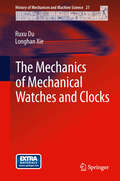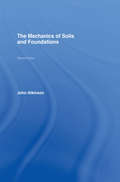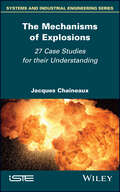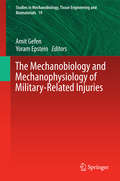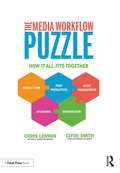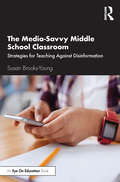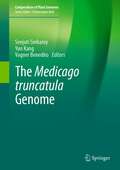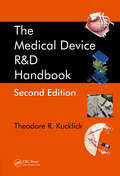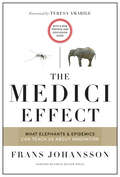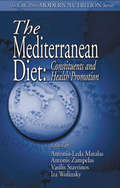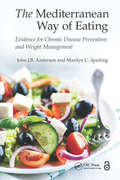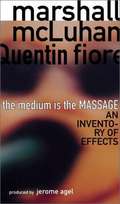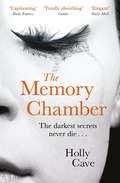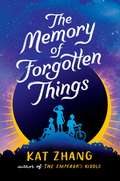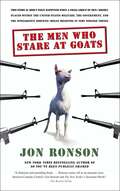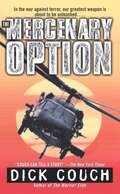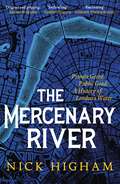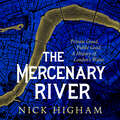- Table View
- List View
The Mechanics of Jointed Structures
by Matthew R. W. BrakeThis book introduces the challenges inherent in jointed structures and guides researchers to the still-open, pressing challenges that need to be solved to advance this critical field. The authors cover multiple facets of interfacial mechanics that pertain to jointed structures: tribological modeling and measurements of the interface surfaces, constitutive modeling of joints, numerical reduction techniques for structures with joints, and uncertainty quantification and propagation for these structures. Thus, the key subspecialties addressed are model reduction for nonlinear systems, uncertainty quantification, constitutive modeling of joints, and measurements of interfacial mechanics properties (including tribology). The diverse contributions to this volume fill a much needed void in the literature and present to a new generation of joints researchers the potential challenges that they can engage in in order to advance the state of the art. Clearly defines internationally recognized challenges in joint mechanics/jointed structures and provides a comprehensive assessment of the state-of-the-art for joint modeling; Identifies open research questions facing joint mechanics; Details methodologies for accounting for uncertainties (due both to missing physics and variability) in joints; Explains and illustrates best-practices for measuring joints' properties experimentally; Maximizes reader understanding of modeling joint dynamics with a comparison of multiple approaches.
The Mechanics of Mechanical Watches and Clocks
by Longhan Xie Ruxu Du"The Mechanics of Mechanical Watches and Clocks" presents historical views and mathematical models of mechanical watches and clocks. Although now over six hundred years old, mechanical watches and clocks are still popular luxury items that fascinate many people around the world. However few have examined the theory of how they work as presented in this book. The illustrations and computer animations are unique and have never been published before. It will be of significant interest to researchers in mechanical engineering, watchmakers and clockmakers, as well as people who have an engineering background and are interested in mechanical watches and clocks. It will also inspire people in other fields of science and technology, such as mechanical engineering and electronics engineering, to advance their designs. Professor Ruxu Du works at the Chinese University of Hong Kong, China. Assistant Professor Longhan Xie works at the South China University of Technology, China.
The Mechanics of Robot Grasping
by Elon Rimon Joel BurdickIn this comprehensive textbook about robot grasping, readers will discover an integrated look at the major concepts and technical results in robot grasp mechanics. A large body of prior research, including key theories, graphical techniques, and insights on robot hand designs, is organized into a systematic review, using common notation and a common analytical framework. With introductory and advanced chapters that support senior undergraduate and graduate level robotics courses, this book provides a full introduction to robot grasping principles that are needed to model and analyze multi-finger robot grasps, and serves as a valuable reference for robotics students, researchers, and practicing robot engineers. Each chapter contains many worked-out examples, exercises with full solutions, and figures that highlight new concepts and help the reader master the use of the theories and equations presented.
The Mechanics of Soils and Foundations
by John AtkinsonIdeal for undergraduates of geotechnical engineering for civil engineers, this established textbook sets out the basic theories of soil mechanics in a clear and straightforward way; combining both classical and critical state theories and giving students a good grounding in the subject which will last right through into a career as a geotechnical engineer. The subject is broken down into discrete topics which are presented in a series of short, focused chapters with clear and accessible text that develops from the purely theoretical to discussing practical applications. Soil behaviour is described by relatively simple equations with clear parameters while a number of worked examples and simple experimental demonstrations are included to illustrate the principles involved and aid reader understanding.
The Mechanisms of Explosions: 27 Case Studies for their Understanding
by Jacques ChaineauxThe risk of explosion is inseparable from industrial activity, as we are often reminded by the news. In order to avoid an explosion, it is necessary to understand the phenomena surrounding it, and take the necessary preventive measures to protect society if it comes to the worst-case scenario. This book will detail these phenomena. The Mechanisms of Explosions presents theoretical aspects from a physicochemical point of view and proposes various methods adapted to each type of explosion, including ATEX explosions. The author shares his knowledge of the mechanisms of explosions, acquired during numerous investigations. These 27 case studies – detailing circumstances, mechanisms and the nature and intensity of explosive effects – were selected to cover all of the possible physical or chemical phenomena, substances and mechanisms, without limiting themselves to the most common situations. This book, packed full of information, is designed to benefit those who analyze and investigate explosions, particularly insurance and judicial experts, prevention engineers, security managers and trainers.
The Mechanobiology and Mechanophysiology of Military-Related Injuries
by Amit Gefen Yoram EpsteinThis book provides a state-of-the-art update, as well as perspectives on future directions of research and clinical applications in the implementation of biomechanical and biophysical experimental, theoretical and computational models which are relevant to military medicine. Such experimental and modeling efforts are helpful, on the one hand, in understanding the aetiology, pathophysiology and dynamics of injury development and on the other hand in guiding the development of better equipment and protective gear or devices that should ultimately reduce the prevalence and incidence of injuries or lessen their hazardous effects. The book is useful for military-oriented biomedical engineers and medical physicists, as well as for military physiologists and other medical specialists who are interested in the science and technology implemented in modern investigations of military related injuries.
The Mechanobiology in Atherosclerosis: Basic, Frontier and Advance
by Guixue WangThis book is based on prior research conducted by the author's team, integrating the latest advancements in biomechanics and mechanobiology related to atherosclerosis from both domestic and international peers. It explores the mechanobiological mechanisms and prevention strategies for atherosclerosis and intravascular stent restenosis. The topics covered include: lipoprotein concentration polarization, stress response of vascular endothelial cells, biomechanical mechanisms in cardiovascular and cerebrovascular development, atherosclerotic plaque formation, in-stent restenosis, and post-stent implantation atherosclerosis. Additionally, the book presents the mechanobiological mechanisms of drug regulation for cell viability and inhibition of vascular restenosis, as well as the latest frontiers and advancements in these areas. It carries significant reference value for postgraduates and young researchers in cardiovascular physiology and pathology, particularly those involved in biomedical engineering, basic medicine, and clinical medicine focused on atherosclerotic disease research.
The Med (A Dan Lenson Novel #1)
by David PoyerIn the tradition of The Caine Mutiny, The Sand Pebbles, and Time and Tide, David Poyer has written a richly detailed military novel of ambition and high adventure. The time is now, the setting is the volatile Eastern Mediterranean, and the scenario is frighteningly familiar. A hundred hostages are taken captive from the American Embassy on the island of Cyprus, and flown to an abandoned hotel in the hills of Syria held by heavily armed and desperate terrorists. The Sixth Fleet, tracked by Soviet spy ships and under fire from hostile aircraft, steams with deadly intent toward the coast of Syria. Two thousand Marines and three thousand sailors mobilize for an operation that needs brutal firepower and exacting precision: a mission of rescue demanding the Navy's weaponry and logistical planning at sea, and the Marines' fierce effectiveness on land. David Poyer, himself a former line officer on destroyers and amphibious ships, has written more than a splendid adventure. The Med is teeming with the ritual, the lore and the intense discipline of military life. Its vivid scenes of celebration on shore leave in an unfamiliar country, the grinding, claustrophobic months at sea, the welcome release of war games and the harrowing fear and adrenaline rush of the real thing, make The Med an absolutely authentic portrait of the Navy today. We follow six major characters throughout the mission: Isaac Sundstrom, the paranoid and fatally indecisive commodore; Dan Lenson, Sundstrom's lieutenant, who must live down a tragic past mistake to save his career; Will "Oreo" Givens, a black Marine torn by conflicts of duty and race; Kelly Wronowicz, the hardbitten, supremely competent engine-man with a vulnerable heart; Susan Lenson, Dan's wife, held hostage with her young daughter by ruthless extremists; and Hanna Abu Harisah, "The Majd," a radical who will fight to the death for his beliefs. Poyer has created a potent mix of people with complex motives that ignite a plot both subtle and exciting-- a tale of increasing tension and explosive finish.
The Media Workflow Puzzle: How It All Fits Together
by Chris LennonThis edited collection brings together a team of top industry experts to provide a comprehensive look at the entire media workflow from start to finish. The Media Workflow Puzzle gives readers an in-depth overview of the workflow process, from production to distribution to archiving. Pulling from the expertise of twenty contributing authors and editors, the book covers topics including content production, postproduction systems, media asset management, content distribution, and archiving and preservation, offering the reader an understanding of all the various elements and processes that go into the media workflow ecosystem. It concludes with an exploration of the possibilities for the future of media workflows and the new opportunities it may bring. Professionals and students alike looking to understand how to manage media content for its entire lifecycle will find this an invaluable resource.
The Media-Savvy Middle School Classroom: Strategies for Teaching Against Disinformation
by Susan Brooks-YoungThe Media-Savvy Middle School Classroom is a practical guide for teachers of Grades 5-8 who want to help their students achieve mastery of media literacy skills. Today’s fake news, alternative facts, and digital manipulations are compromising the critical thinking and well-being of middle grade learners already going through significant personal changes. This actionable book prepares teachers to help their students become informed consumers of online resources. Spanning correct source use, personal versus expert opinions, deliberate disinformation, social media, and more, these ready-to-use activities can be integrated directly into existing language arts and mathematics lesson plans.
The Medicago truncatula Genome (Compendium of Plant Genomes)
by Senjuti Sinharoy Yun Kang Vagner BeneditoThis book focuses on the discoveries in M. truncatula genomic research which has been undertaken in the last two decades. Legumes are important for their economic values as food, feed, and fodder and also serve as the pillar of sustainable agriculture because of its biological nitrogen fixation capacity. Medicago truncatula was established as a model legume in the 1990s and has been well adopted as a model internationally since then. M. truncatula is an autogamous, diploid (2n = 16) species with a short generation time, and relatively small genome size (~375 Mbp). The M. truncatula genome was initially sequenced by the International Medicago Genome Annotation Group (IMGAG) in 2011 and has been well-annotated. M. truncatula research benefits from the availability of several genetic and genomic tools, such as gene expression atlas (MtGEA), insertion and neutron bombardment mutant populations, and a HapMap panel containing 384 sequenced inbred lines for genome-wide association studies. This book covers the current status and latest advancements of the M. truncatula genomics and transcriptomics resources along with a glimpse of newly developed tools that makes M. truncatula a front runner model in functional genomic studies.
The Medical Device R&D Handbook
by Theodore R. KucklickExploring the practical, entrepreneurial, and historical aspects of medical device development, this second edition of The Medical Device R&D Handbook provides a how-to guide for medical device product development. The book offers knowledge of practical skills such as prototyping, plastics selection, and catheter construction, allowing designer
The Medici Effect: What Elephants And Epidemics Can Teach Us About Innovation
by Frans Johansson<p>With Amazon Business, you would have saved $212.15 in the last year. Create a free account and save up to 13% today.</p><p>Why do so many world-changing insights come from people with little or no related experience? Charles Darwin was a geologist when he proposed the theory of evolution. And it was an astronomer who finally explained what happened to the dinosaurs.</p><p>Frans Johansson's The Medici Effect shows how breakthrough ideas most often occur when we bring concepts from one field into a new, unfamiliar territory and offers examples of how we can turn the ideas we discover into path-breaking innovations.</p><p>Clayton M. Christensen, bestselling author of The Innovator's Dilemma, has described The Medici Effect as "one of the most insightful books about managing innovation I have ever read. Its assertion that breakthrough principles of creativity occur at novel intersections is an enduring principle of creativity that should guide innovators in every field."</p><p>Now with a new preface and a discussion guide, and a foreword by Harvard Business School professor Teresa Amabile, The Medici Effect is a timeless classic that will help you reach your innovative peak.</p>
The Medieval Peutinger Map
by Emily AlbuThe Peutinger Map remains the sole medieval survivor of an imperial world-mapping tradition. It depicts most of the inhabited world as it was known to the ancients, from Britain's southern coastline to the farthest reaches of Alexander's conquests in India, showing rivers, lakes, islands, and mountains while also naming regions and the peoples who once claimed the landscape. Onto this panorama, the mapmaker has plotted the ancient Roman road network, with hundreds of images along the route and distances marked from point to point. This book challenges the artifact's self-presentation as a Roman map by examining its medieval contexts of crusade, imperial ambitions, and competition between the German-Roman Empire and the papacy.
The Mediterranean Diet: Constituents and Health Promotion (Modern Nutrition)
by Antonis Zampelas Ira Wolinsky Antonia-Leda Matalas Vassilis StavrinosAdults living in certain olive-growing areas of the Mediterranean Basin display high life expectancies and rates of chronic disease that are among the lowest in the world. These benefits are achieved despite socioeconomic indicators that are often much lower than those of more industrial nations in North America and Europe. Attention has focused on
The Mediterranean Way of Eating: Evidence for Chronic Disease Prevention and Weight Management
by John J.B. Anderson Marilyn C. SparlingThis book presents evidence-based research that validates the traditional Mediterranean way of eating with respect to health. It offers information about an enjoyable, healthy way of eating that has stood the test of time, along with practical suggestions for incorporating the Mediterranean diet into daily life. The book addresses nutrients found in Mediterranean foods, how they function in the body, and why they are essential for optimal health. It highlights the Mediterranean diet's effectiveness in weight management and prevention and treatment of various chronic diseases.
The Medium Is the Massage: An Inventory of Effects
by Marshall Mcluhan Quentin FioreFirst published in 1967, this text is now more relevant than ever, as McLuhan's foresights about the impact of new media is actualized at unprecedented speeds via the Internet. It portrays technologies as an extension of man, illustrating how our senses are massaged and our preceptions altered as these devices become integral parts of our lives.
The Membrane-Coupled Activated Sludge Process in Municipal Wastewater Treatment
by Berthold GuenderThis book represents a milestone. It is the first overall presentation that summarizes the membrane-coupled activated sludge process (MCASP) in its entirety. The volume offers a thorough survey of current know-how, an explanation of the operational MCASP in municipal plants with full-scale membrane modules, and a description of its advantages and d
The Memory Chamber: An elegant tale of love and loss
by Holly Cave'Vivid, compelling, and thought-provoking. Utterly original' Will Dean, author of Dark Pines 'At last a book that has it all. So beautifully written. I loved it' Amazon Reviewer**********An afterlife of your own design - what could go wrong? Isobel designs artificial 'heavens' for her clients, created from the memories they treasure most. She works for Oakley Associates, London's most prestigious firm of its kind. Her heavens are renowned for their beauty and perfection.But Isobel crosses an ethical line when she falls for Jarek, a new - and married - client. Then, in the wake of his wife's murder, Isobel uncovers a darker and deadlier side of the world she works in. As her life starts falling apart, Isobel realises that nothing is as perfect as it seems, not even heaven itself...**********'Wow! I started this book mid afternoon and finished it at 1:15 am. I just could not put it down' Amazon Reviewer'An elegant tale of love and loss, memory and murder, set in an edgy near-future' Daily Mail
The Memory Chamber: An elegant tale of love and loss
by Holly Cave'Vivid, compelling, and thought-provoking. Utterly original' Will Dean, author of Dark Pines 'At last a book that has it all. So beautifully written. I loved it'Amazon Reviewer**********An afterlife of your own design - what could go wrong?Isobel designs artificial 'heavens' for her clients, created from the memories they treasure most. She works for Oakley Associates, London's most prestigious firm of its kind. Her heavens are renowned for their beauty and perfection.But Isobel crosses an ethical line when she falls for Jarek, a new - and married - client. Then, in the wake of his wife's murder, Isobel uncovers a darker and deadlier side of the world she works in. As her life starts falling apart, Isobel realises that nothing is as perfect as it seems, not even heaven itself...**********'Wow! I started this book mid afternoon and finished it at 1:15 am. I just could not put it down' Amazon Reviewer'An elegant tale of love and loss, memory and murder, set in an edgy near-future'Daily Mail
The Memory of Forgotten Things
by Kat ZhangIn the tradition of The Thing About Jellyfish and When You Reach Me, acclaimed author Kat Zhang offers a luminous and heartbreaking novel about a girl who is convinced that an upcoming solar eclipse will bring back her dead mother. <P><P>One of the happiest memories twelve-year-old Sophia Wallace has is of her tenth birthday. Her mother made her a cake that year—and not a cake from a boxed-mix, but from scratch. She remembers the way the frosting tasted, the way the pink sugar roses dissolved on her tongue. This memory, and a scant few others like it, is all Sophia has of her mother, so she keeps them close. She keeps them secret, too. Because as paltry as these memories are, she shouldn’t have them at all. The truth is, Sophia Wallace’s mother died when she was six years old. But that isn’t how she remembers it. Not always. Sophia has never told anyone about her unusual memories—snapshots of a past that never happened. But everything changes when Sophia’s seventh grade English class gets an assignment to research solar eclipses. She becomes convinced that the upcoming solar eclipse will grant her the opportunity to make her alternate life come true, to enter a world where her mother never died. <P><P>With the help of two misfit boys, she must figure out a way to bring her mother back to her—before the opportunity is lost forever.
The Men Who Stare at Goats
by Jon RonsonBizarre military history: In 1979, a crack commando unit was established by the most gifted minds within the U.S. Army. Defying all known laws of physics and accepted military practice, they believed that a soldier could adopt the cloak of invisibility, pass cleanly through walls, and--perhaps most chillingly--kill goats just by staring at them. They were the First Earth Battalion, entrusted with defending America from all known adversaries. And they really weren't joking. What's more, they're back--and they're fighting the War on Terror. An uproarious exploration of American military paranoia: With investigations ranging from the mysterious "Goat Lab," to Uri Geller's covert psychic work with the CIA, to the increasingly bizarre role played by a succession of U.S. presidents, this might just be the funniest, most unsettling book you will ever read--if only because it is all true and is still happening today.
The Mercenary Option
by CouchAfter losing his son in the September 11 attacks, wealthy industrialist Joseph Simpson forms the Intervention Force (IFOR) -- a surgical strike team led by former Navy SEAL Garrett Walker. Officially, the group is a rogue operation with no government affiliation. But when the impossible becomes absolutely necessary, IFOR is... THE MERCENARY OPTION Shortly after the terror attacks on America, the American president announces the construction of an oil pipeline across Afghanistan. To stop this, and deter further Western encroachment in Central Asia, a vindictive Saudi prince retains ex-KGB terror broker Pavel Zelinkow -- a prime mover behind al Qaeda's 9/11 attack. Zelinkow plans to steal two nuclear weapons, detonating one of them among the pipeline construction crews and their military guardians, while the target of the second bomb is a mystery. U.S. special operations forces cannot be used against the terrorists hiding in Iran, so IFOR is called into action for the first time on a mission that will test them to their limits: take out the terrorists, recover the nukes, and get Zelinkow -- dead or alive.
The Mercenary River: Private Greed, Public Good: A History of London's Water
by Nick HighamAnyone interested in the real London needs to read this. - Andrew MarrNo city can survive without water, and lots of it. Today we take the stuff for granted: turn a tap and it gushes out. But it wasn't always so. For centuries London, one of the largest and richest cities in the world, struggled to supply its citizens with reliable, clean water. The Mercenary River tells the story of that struggle from the middle ages to the present day. Based on new research, it tells a tale of remarkable technological, scientific and organisational breakthroughs; but also a story of greed and complacency, high finance and low politics. Among the breakthroughs was the picturesque New River, neither new nor a river but a state of the art aqueduct completed in 1613 and still part of London's water supply: the company that built it was one of the very first modern business corporations, and also one of the most profitable. London water companies were early adopters of steam power for their pumps. And Chelsea Waterworks was the first in the world to filter the water it supplied its customers: the same technique is still used to purify two-thirds of London's drinking water. But for much of London's history water had to be rationed, and the book also chronicles our changing relationship with water and the way we use it. Amongst many stories, Nick Higham's page-turning narrative uncovers the murky tale of how the most powerful steam engine in the world was first brought to London; the extraordinary story of how one Victorian London water company deliberately cut off 2,000 households, even though it knew they had no alternative source of supply; the details of a financial scandal which brought two of the water companies close to collapse in the 1870s; and finally asks whether today's 21st century water companies are an improvement on their Victorian predecessors.
The Mercenary River: Private Greed, Public Good: A History of London's Water
by Nick HighamNo city can survive without water, and lots of it. Today we take the stuff for granted: turn a tap and it gushes out. But it wasn't always so. For centuries London, one of the largest and richest cities in the world, struggled to supply its citizens with reliable, clean water. The Mercenary River tells the story of that struggle from the middle ages to the present day. Based on new research, it tells a tale of remarkable technological, scientific and organisational breakthroughs; but also a story of greed and complacency, high finance and low politics. Among the breakthroughs was the picturesque New River, neither new nor a river but a state of the art aqueduct completed in 1613 and still part of London's water supply: the company that built it was one of the very first modern business corporations, and also one of the most profitable. London water companies were early adopters of steam power for their pumps. And Chelsea Waterworks was the first in the world to filter the water it supplied its customers: the same technique is still used to purify two-thirds of London's drinking water. But for much of London's history water had to be rationed, and the book also chronicles our changing relationship with water and the way we use it.Amongst many stories, Nick Higham's compelling narrative uncovers the murky tale of how the most powerful steam engine in the world was first brought to London; the extraordinary story of how one Victorian London water company deliberately cut off 2,000 households, even though it knew they had no alternative source of supply; the details of a financial scandal which brought two of the water companies close to collapse in the 1870s; and finally asks whether today's 21st century water companies are an improvement on their Victorian predecessors.(P) 2022 Headline Publishing Group Ltd

